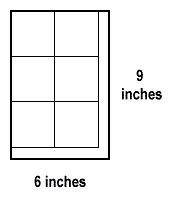Chinese Calendar Box
 Introduction
Introduction China Temple, a Chinese restaurant in Las Cruces, New Mexico, gives away at the beginning of each year, calendars made from thin slats. The calendars advertise the restaurant, and they are rolled up and delivered in long flat boxes, as shown here. (The measurements given are approximate.) Activity 1. Make a cube with the same volume as the Chinese calendar box. Decide how much paper you need. Compute the surface area of your cube. Make a plan for the cube and construct it.
How to compute the cube root of 21.914062 [ top ] a. The square root and cube root keys on many scientific calculator look like this:
Some calculators do not have the cube root key at all but most calculators do at least have the square root key. You should check this on your own calculator. With a TI-30Xa or other advanced scientific calculators, entering: and then using the cube root button, gives 2.79838606 inches. Entering the [2nd] button (called the 2nd function button) allows you to do the opposite of the next key entered. Entering gives .79838606; then entering gives 12.77417696 (which rounds up to 13). So, to the nearest 16th of an inch, the side length S is 2 13/16 inches. b. Without a calculator: [ top ] We can do the following exercise. We know that 2³ = 8, and 3³ = 27, so the cube root of 21.914062 is between 2 and 3.
Let's try starting with 2.5: 2.9³ = 24.389 -- too big, 2.8³ = 21.952 -- just a bit too big, but given our precision of measurement, it is good enough.
c. With a calculator: [ top ] We can do the following
exercise. Here is a program that you can execute on your
TI-108 calculator to find the cube root of any number x.
(my guess must be greater than zero) repeat the following keystrokes: Continue until you get an adequate accuracy.
 We need six
squares for the surface of the cube, and each is less than 3 inches on
a side. We can make the cube from two rectangles, each consisting of
three such squares. So using a rectangle that is 6 inches by 9
inches, we can make a plan for the
cube, with a little left over. We need six
squares for the surface of the cube, and each is less than 3 inches on
a side. We can make the cube from two rectangles, each consisting of
three such squares. So using a rectangle that is 6 inches by 9
inches, we can make a plan for the
cube, with a little left over.
Using a 6 inch by 9 inch sheet, design the squares and cut out and assemble the cube. 2. Make a copy of the original Chinese calendar box. 3. In each case (cubic box and Chinese calendar box), what percentage of the paper you used was needed for the surface of the box? 4. If you were teaching this lesson, what would be its cost, assuming you already have tape, scissors, rulers, and calculators? |
